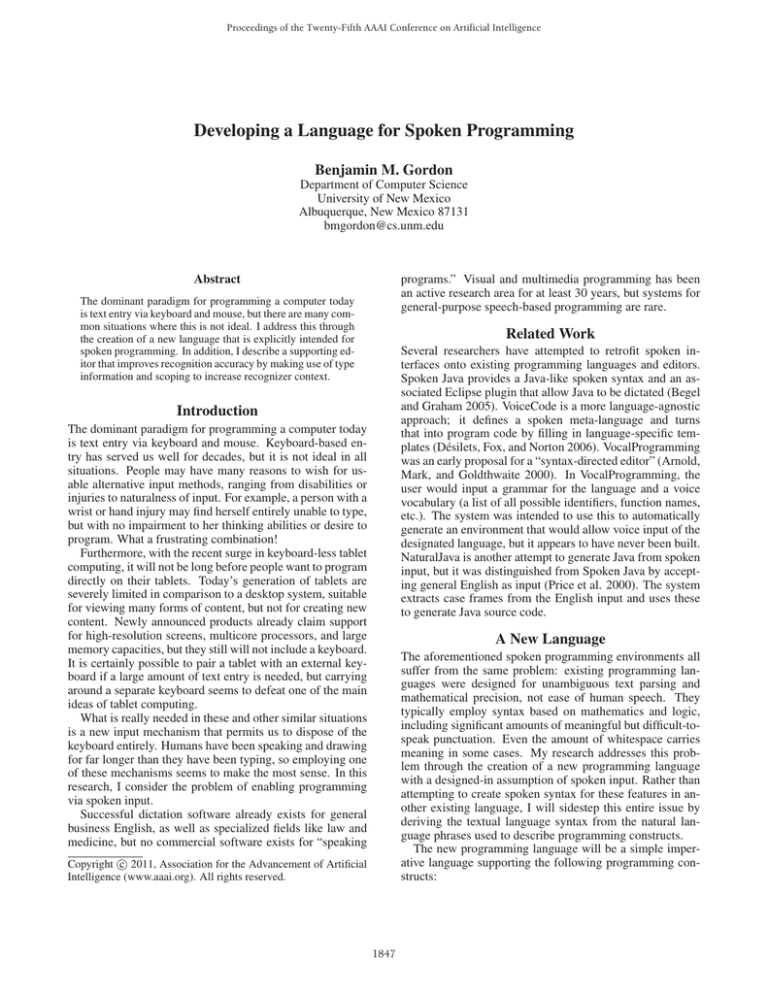
Proceedings of the Twenty-Fifth AAAI Conference on Artificial Intelligence
Developing a Language for Spoken Programming
Benjamin M. Gordon
Department of Computer Science
University of New Mexico
Albuquerque, New Mexico 87131
bmgordon@cs.unm.edu
programs.” Visual and multimedia programming has been
an active research area for at least 30 years, but systems for
general-purpose speech-based programming are rare.
Abstract
The dominant paradigm for programming a computer today
is text entry via keyboard and mouse, but there are many common situations where this is not ideal. I address this through
the creation of a new language that is explicitly intended for
spoken programming. In addition, I describe a supporting editor that improves recognition accuracy by making use of type
information and scoping to increase recognizer context.
Related Work
Several researchers have attempted to retrofit spoken interfaces onto existing programming languages and editors.
Spoken Java provides a Java-like spoken syntax and an associated Eclipse plugin that allow Java to be dictated (Begel
and Graham 2005). VoiceCode is a more language-agnostic
approach; it defines a spoken meta-language and turns
that into program code by filling in language-specific templates (Désilets, Fox, and Norton 2006). VocalProgramming
was an early proposal for a “syntax-directed editor” (Arnold,
Mark, and Goldthwaite 2000). In VocalProgramming, the
user would input a grammar for the language and a voice
vocabulary (a list of all possible identifiers, function names,
etc.). The system was intended to use this to automatically
generate an environment that would allow voice input of the
designated language, but it appears to have never been built.
NaturalJava is another attempt to generate Java from spoken
input, but it was distinguished from Spoken Java by accepting general English as input (Price et al. 2000). The system
extracts case frames from the English input and uses these
to generate Java source code.
Introduction
The dominant paradigm for programming a computer today
is text entry via keyboard and mouse. Keyboard-based entry has served us well for decades, but it is not ideal in all
situations. People may have many reasons to wish for usable alternative input methods, ranging from disabilities or
injuries to naturalness of input. For example, a person with a
wrist or hand injury may find herself entirely unable to type,
but with no impairment to her thinking abilities or desire to
program. What a frustrating combination!
Furthermore, with the recent surge in keyboard-less tablet
computing, it will not be long before people want to program
directly on their tablets. Today’s generation of tablets are
severely limited in comparison to a desktop system, suitable
for viewing many forms of content, but not for creating new
content. Newly announced products already claim support
for high-resolution screens, multicore processors, and large
memory capacities, but they still will not include a keyboard.
It is certainly possible to pair a tablet with an external keyboard if a large amount of text entry is needed, but carrying
around a separate keyboard seems to defeat one of the main
ideas of tablet computing.
What is really needed in these and other similar situations
is a new input mechanism that permits us to dispose of the
keyboard entirely. Humans have been speaking and drawing
for far longer than they have been typing, so employing one
of these mechanisms seems to make the most sense. In this
research, I consider the problem of enabling programming
via spoken input.
Successful dictation software already exists for general
business English, as well as specialized fields like law and
medicine, but no commercial software exists for “speaking
A New Language
The aforementioned spoken programming environments all
suffer from the same problem: existing programming languages were designed for unambiguous text parsing and
mathematical precision, not ease of human speech. They
typically employ syntax based on mathematics and logic,
including significant amounts of meaningful but difficult-tospeak punctuation. Even the amount of whitespace carries
meaning in some cases. My research addresses this problem through the creation of a new programming language
with a designed-in assumption of spoken input. Rather than
attempting to create spoken syntax for these features in another existing language, I will sidestep this entire issue by
deriving the textual language syntax from the natural language phrases used to describe programming constructs.
The new programming language will be a simple imperative language supporting the following programming constructs:
c 2011, Association for the Advancement of Artificial
Copyright Intelligence (www.aaai.org). All rights reserved.
1847
1. String literals and variables
programming, traditional auto-completion is not needed, because the programmer will be inclined to speak full words.
Having to stop and spell out the first few symbols of an identifier would be a net time loss over simply speaking it out
even if the auto-completion always guessed the correct symbol. However, voice input is typically ambiguous, forcing
the speech recognizer to use probabilistic methods to select
the output text based on known patterns of English sentences
and prior training corpora.
Due to locality of reference, a programmer is more
likely to refer to a nearby symbol than one several nested
scopes away from the current line. The extension of autocompletion to voice input is then obvious: Instead of autocompleting symbols based on the first few characters typed,
a vocal programming system should use scoping to automatically raise the expected probability of more closely scoped
symbols and lower the probability of more remote symbols.
I conjecture that this will reduce the number of recognition
errors and improve accuracy.
A second use of context is the type system. To save the
programmer from the burden of declaring the types of most
variables and functions, many modern languages are either
dynamically typed or make use of type inference. Dynamic
typing is powerful and easy for the programmer, but prevents the editor from knowing anything about the types before runtime. With type inference, on the other hand, the
programmer is still free to use variables without worrying
about type signatures, but the compiler is still able to perform compile-time validation. More importantly for the purposes of this project, the editor can also perform type inference to gain additional context information about symbols in
the program. This additional context will be used similarly
to scoping to enhance the selection of spoken symbols.
For example, suppose that functions “flop” and “flap” are
both in scope. Without further context, it will be difficult
to distinguish between these two functions when spoken. If
“flop” is known to take an integer and “flap” is known to
take a string, then the editor can immediately improve its
accuracy by entering the correct function based on which
type of variable the user passes as a parameter.
2. Integer and floating point literals and variables
3. Variable assignment
4. Simple arithmetic expressions and string operations
5. Function definitions
6. Function calls, including recursion
7. Indefinite loops (while-do/repeat-until equivalent)
8. Conditional statements (if-then-else equivalent)
9. Simple I/O (print and read equivalents)
I will create English-like syntax for each of the supported programming constructs. The syntax will be primarily word-based so that the spoken syntax of the language
will match the textual representation. As a trivial example,
instead of an assignment statement looking like
X := 5;
an assignment might be
Set X to 5
Punctuation and symbols will be used only where standardized pronunciations exist for them, such as notation used in
arithmetic expressions.
The language will be statically typed, but will employ
type inference rather than requiring the programmer to annotate variables and functions with type information. This
reduces the amount of syntax that needs to be supported and
recognized. It also provides additional contextual information to the editor, as will be described below.
This minimalist language would hardly constitute a credible suggestion for use in any serious modern software development project, but it provides enough features to solve
basic programming problems, such as those that students
might be tasked with in their first semester or two of computer science classes. It is not intended to be a productionready language for real software engineering. Once the concept has been proven to be viable, that type of enhancement
provides many potential topics for further research.
References
Programming Environment
Arnold, S. C.; Mark, L.; and Goldthwaite, J. 2000. Programming by voice, vocalprogramming. In Proceedings of
the fourth international ACM conference on Assistive technologies, Assets ’00, 149–155. New York, NY, USA: ACM.
Begel, A., and Graham, S. L. 2005. Spoken programs. In
2005 IEEE Symposium on Visual Languages and HumanCentric Computing (VL/HCC’05), 99–106.
Désilets, A.; Fox, D. C.; and Norton, S. 2006. Voicecode: an
innovative speech interface for programming-by-voice. In
CHI ’06 extended abstracts on Human factors in computing
systems, CHI EA ’06, 239–242. New York, NY, USA: ACM.
Price, D.; Rilofff, E.; Zachary, J.; and Harvey, B. 2000.
Naturaljava: a natural language interface for programming
in java. In Proceedings of the 5th international conference
on Intelligent user interfaces, IUI ’00, 207–211. New York,
NY, USA: ACM.
Speech-convenient syntax alone is not sufficient to enable
productive programming. In addition, a programmer needs
an environment that supports spoken entry and editing of
program text. Therefore, the second component of this research is an integrated development environment (IDE) that
will provide optimizations for speech input.
In particular, context is a critical factor in correctly recognizing speech. The editor will take advantage of this by incorporating language context into its recognition algorithms
and/or speech models. There are many types of context that
might be of interest, but I am focusing on two specific areas:
scoping and typing information.
First, the editor will be aware of scoping. Many existing
editors use scoping with auto-completion to suggest variable
names, functions, or other symbols that are in scope when
the user types the first few characters of the name. In voice
1848








